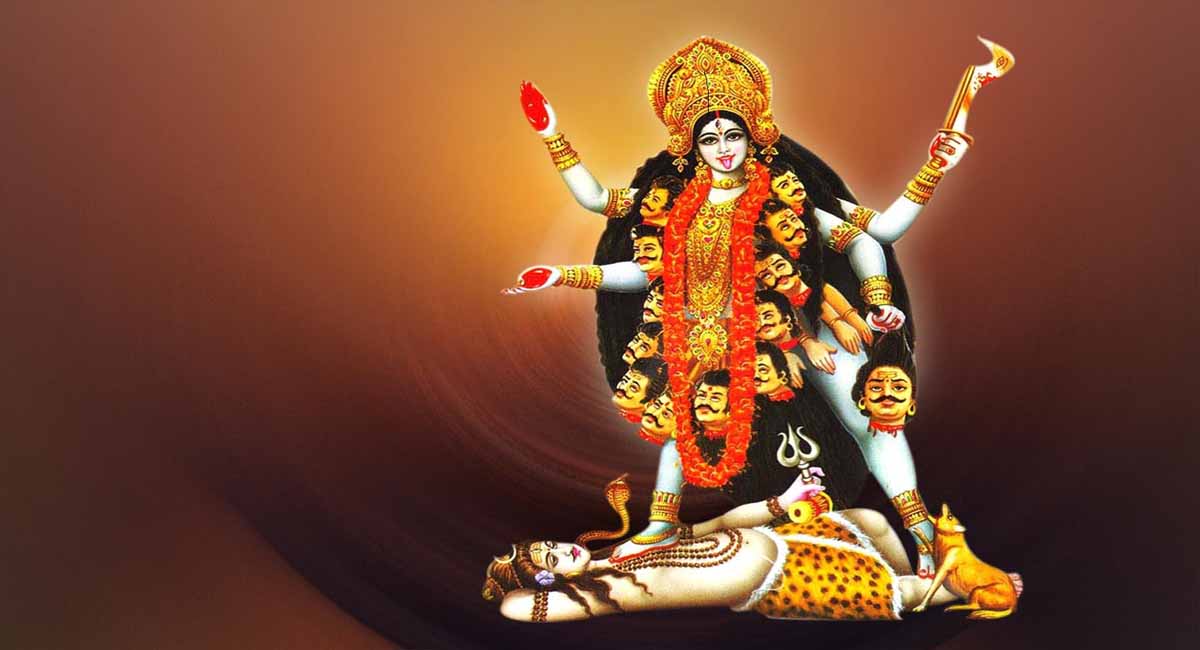Kali Mata is a Hindu goddess who is widely worshiped in India and Nepal. She is considered as the embodiment of Shakti, which represents the feminine energy or power of the universe. Kali Mata is often depicted as a fierce and powerful goddess, who is both fearsome and compassionate. Her worship is an integral part of the Hindu religion, particularly in the Tantric sects.
Kali Mata Photos 2023
Discover the mesmerizing beauty of Kali Mata photos through our stunning collection of 2023. Immerse yourself in the divine aura of the goddess and witness the intricacies of her intricate idols and temples captured in breathtaking detail. Let these photos transport you to the mystical realm of Kali Mata, where you can experience the wonder and devotion of her worshipers. Don’t miss the opportunity to add these exquisite images to your collection and connect with the divine energy of Kali Mata.
[ngg src=”galleries” ids=”4″ display=”basic_thumbnail” override_thumbnail_settings=”1″ thumbnail_crop=”0″ number_of_columns=”3″]The mythology of Kali Mata
According to Hindu mythology, Kali Mata was created from the forehead of the Durga Maa, during a battle with the demon Mahishasura. She was created as a warrior goddess to aid Durga Maa in her battle against the demon. Kali Mata is often depicted with a dark complexion, wearing a garland of skulls around her neck and holding weapons in her many arms.
Different versions of Kali Mata’s mythological stories exist in Hindu mythology. One popular story is that Kali Mata was born when the goddess Parvati was so enraged by the demon Raktabija that she turned into a fierce and destructive goddess. Another story suggests that Kali Mata was created to destroy the demon Daruka, who had terrorized the gods and goddesses.
Kali Mata is represented in Hindu mythology in various forms, such as the ten Mahavidyas or the ten great wisdom goddesses. She is also associated with the goddess Chandi and is considered as a form of Durga Maa. Kali Mata is often worshiped during the festival of Diwali, which is celebrated in many parts of India.
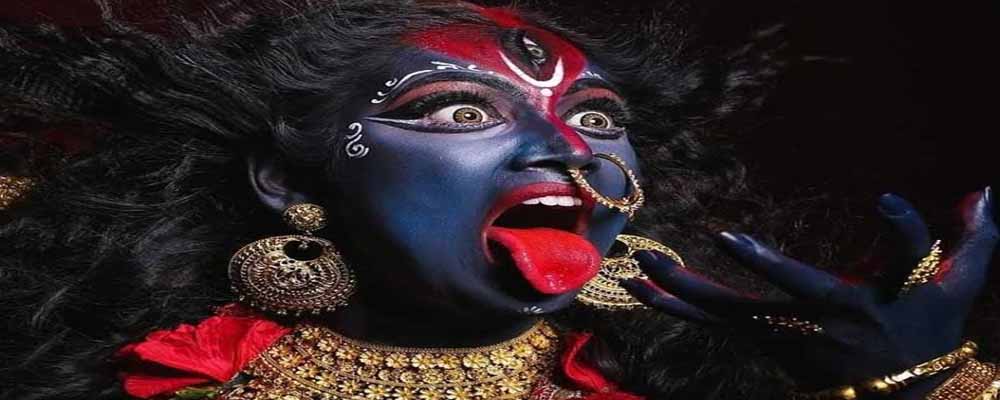
Significance of Kali Mata
- Kali Mata is worshipped in Hinduism through various rituals and ceremonies. Devotees offer flowers, incense, and food to the goddess and perform aarti, a ritual of waving a lighted lamp in front of the deity. Some devotees also practice meditation and yoga to connect with the energy of Kali Mata.
- Kali Mata is known by different names in different regions of India. In Bengal, she is known as Shyama, while in Tamil Nadu, she is called Kottavei. In Rajasthan, she is known as Karni Mata, and in Maharashtra, she is known as Mahakali.
- Kali Mata is often associated with the destruction of evil. She is believed to protect her devotees from harm and to remove obstacles in their lives. Kali Mata’s fierce appearance and weapons are seen as symbolic of her power to destroy negative forces.
- Kali Mata is also closely associated with the god Shiva. In some depictions, Kali Mata is shown standing on Shiva, who lies motionless beneath her. This represents the interplay between creation and destruction in the universe.
Depiction of Kali Mata
- In Hindu art, Kali Mata is depicted with a dark complexion, wild hair, and multiple arms. She is often shown wearing a skirt made of human arms and a garland of skulls around her neck. Her tongue is also usually sticking out, which represents her intense focus and concentration.
- The symbolism behind Kali Mata’s appearance is complex. Her dark complexion represents the dark aspects of the universe, while her wild hair symbolizes her freedom from social norms. The multiple arms represent her ability to perform multiple tasks at once, while her skirt made of human arms symbolizes the destruction of ego and the shedding of negative attachments.
- Kali Mata’s weapons and ornaments also have significant meaning. The sword represents the power of knowledge, while the trident represents the three aspects of creation, preservation, and destruction. The severed head in her hand represents the victory of the goddess over the ego.
Festivals Celebrating Kali Mata
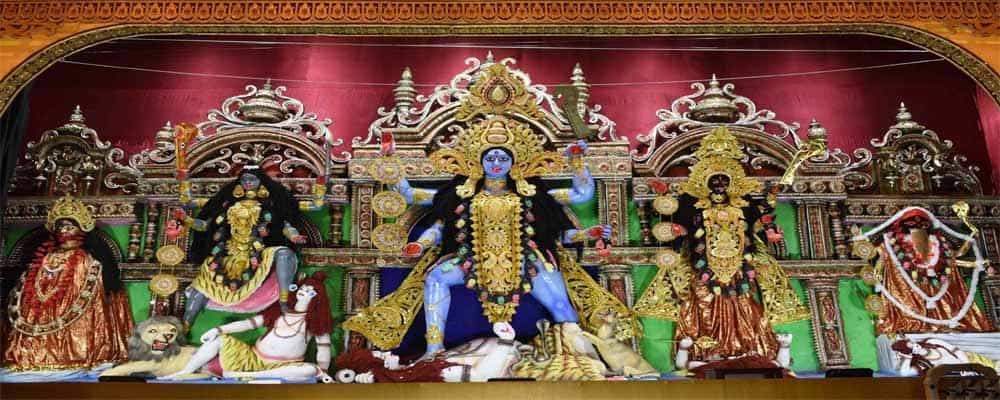
- Navratri and Durga Puja are two major festivals celebrated in India that honor Kali Mata. These festivals last for nine days and are dedicated to the worship of various forms of the goddess.
- Kali Puja is another festival that celebrates Kali Mata. It is celebrated on the new moon day of the Hindu month of Kartik, which falls in October or November. The festival is particularly popular in Bengal and involves offerings of food, flowers, and lamps to the goddess.
- Other festivals that celebrate Kali Mata include Diwali, the festival of lights, and Holi, the festival of colors. In these festivals, Kali Mata is worshipped alongside other Hindu deities as a symbol of the triumph of good over evil.
Philosophy of Kali Mata
- Kali Mata is closely associated with Tantra and Shakta philosophy, which emphasizes the worship of the divine feminine. Tantra and Shakta philosophy see the universe as a manifestation of the divine feminine energy, which is represented by Kali Mata.
- In modern times, Kali Mata’s philosophy is often interpreted as a symbol of female empowerment and liberation. Her fierce appearance and weapons are seen as symbols of women’s strength and their ability to fight against oppression and discrimination.
- Kali Mata’s philosophy is relevant in modern times as it highlights the importance of respecting and valuing the feminine aspect of the universe. Her teachings encourage individuals to embrace their inner strength and to fight against injustice and inequality.
Kali Mata’s Influence in Pop Culture
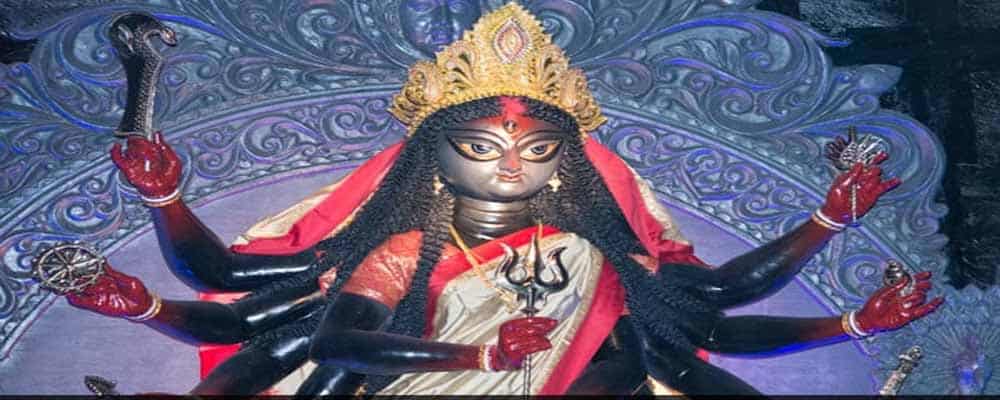
- In popular culture, Kali Mata is often depicted as a powerful and fierce goddess. Her image has been used in music videos, video games, and other forms of media to represent strength and power.
- Kali Mata has also been depicted in literature and art. Writers and artists have explored her mythology and symbolism to create works that reflect on themes of power, feminism, and spirituality.
- Kali Mata has been featured in movies and television shows, both in India and abroad. Her image has been used to create strong female characters who embody the spirit of empowerment and liberation.
Controversies Surrounding Kali Mata
- Some critics have raised concerns about Kali Mata’s depiction as a violent goddess. They argue that her image reinforces negative stereotypes about women as angry and vengeful.
- Animal sacrifice is sometimes practiced in Kali Mata’s worship, which has sparked controversy and criticism from animal rights activists and other groups.
- There are debates over Kali Mata’s feminist image, with some arguing that her portrayal as a fierce warrior goddess reinforces patriarchal norms by suggesting that women can only be strong if they take on masculine traits.
Kali Mata’s Worship Around the World
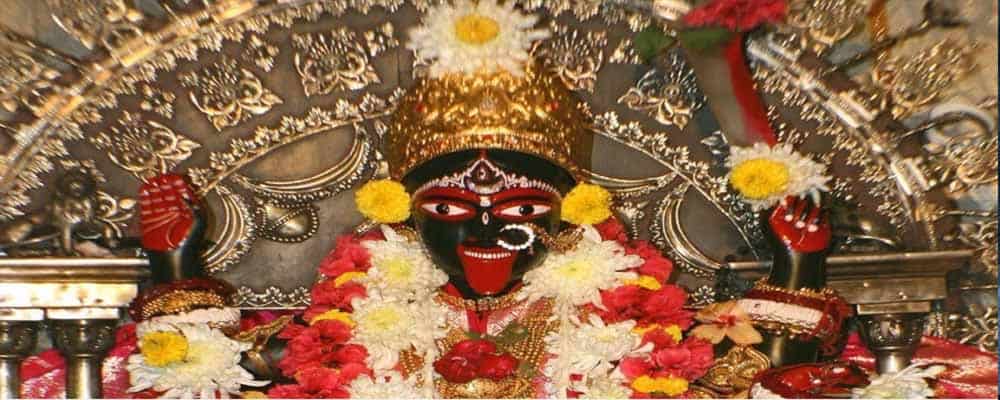
- Kali Mata is widely worshipped in India, particularly in Bengal, where she is considered the patron goddess. Her temples can be found across the country, and her festivals are celebrated with great fervor.
- Kali Mata is also worshipped in other parts of Asia, including Nepal, Sri Lanka, and Thailand. In these countries, her worship is often combined with other religious traditions and cultural practices.
- Kali Mata’s worship has spread to the Western world, where her image and teachings have been embraced by spiritual seekers and practitioners of alternative religions. Her philosophy of female empowerment and liberation has resonated with many individuals, particularly women, who are seeking to reclaim their power and embrace their inner strength.
Famous Temples – Kali Mata Mandir
- Kalighat Kali Temple in Kolkata, West Bengal, is one of the most famous temples dedicated to Kali Mata. It is believed to be one of the 51 Shakti Peethas, or holy shrines, associated with the goddess.
- Dakshineswar Kali Temple, also located in Kolkata, is another popular temple dedicated to Kali Mata. It was built in the 19th century by Rani Rashmoni, a prominent philanthropist and devotee of the goddess.
- Kamakhya Temple in Assam is another important shrine dedicated to Kali Mata. It is one of the 51 Shakti Peethas and is known for its association with the fertility goddess Kamakhya.
- Other famous temples of Kali Mata include the Kali Temple in Varanasi, the Tarapith Temple in West Bengal, and the Chandi Devi Temple in Uttarakhand.
Kali Mata and Feminism
- Kali Mata’s depiction as a powerful and fierce goddess has made her a symbol of feminine power and strength. Her image is often used to represent women’s ability to overcome oppression and to fight for their rights.
- Kali Mata’s worship has empowered women in India by providing them with a source of inspiration and strength. Many women see her as a role model and a source of support in their daily lives.
- Kali Mata’s influence can be seen in feminist movements in India, where her teachings of female empowerment and liberation have been embraced by women’s rights activists. Her image and mythology have been used to create a sense of unity and solidarity among women who are fighting for gender equality and social justice.
Shri Kali Chalisa Lyrics in English & Hindi
Shri Kali Chalisa is a devotional hymn that is believed to bring various benefits to its devotees. This prayer is dedicated to the goddess Kali, who is associated with power, protection, and liberation. The recitation of Shri Kali Chalisa is said to help devotees overcome obstacles, attain success, and seek spiritual guidance. It is also believed to protect them from negative energies and promote overall well-being. Through the practice of Shri Kali Chalisa, devotees can deepen their connection with Kali and experience her divine energy.
| Shri Kali Chalisa Lyrics in English |
| Jaykaali Kalimalaharan, Mahima Agam Apaar, Mahish Mardini Kaalika, Dehu Abhay Apaar. Ari Mad Maan Mitaavan Haari, Mundamaal Gal Sohat Pyaari. Ashtabhuji Sukhdaayak Maata, Dushtdalan Jag Me Vikhyaata. Bhaal Vishaal Mukut Chhavi Chhajei, Kar Me Shish Shatru Ka Saajei. Dooje Haath Liye Madhu Pyaala, Haath Tiisare Sohat Bhaala. Chauthe Khappar Khadag Kar Paanche, Chhathe Trishul Shatru Bal Jaanche. Saptam Kar Damakat Asi Pyaari, Shobha Adbhut Maat Tumhaari. Ashtam Kar Bhaktan Var Data, Jag Manharan Roop Ye Maata. Bhaktan Me Anurakt Bhavaani, Nishdin Rate Rishi-Muni Gyaani. Mahaashakti Ati Prabal Punita, Tu Hi Kaali Tu Hi Sita. Patit Taarini He Jag Paalak, Kalyaani Paapi Kul Ghaalak. Shesh Suresh Na Paavat Paara, Gauri Roop Dharyo Ek Baara. Tum Samaan Daata Nahi Dooja, Vidhivat Kare Bhaktajan Pooja. Roop Bhayankar Jab Tum Dhaara, Dushtadalan Kinhehu Sanhaara. Naam Anekan Maat Tumhaare, Bhaktajano Ke Sankat Taare. Kali Ke Kasht Kaleshan Harani, Bhav Bhay Mochan Mangal Karani. Mahima Agam Ved Yash Gaavei, Naarad Shaarad Paar Na Paavei. Bhoo Par Bhaar Badhyau Jab Bhaari, Tab Tab Tum Prakati Mahtaari. Aadi Anaadi Abhay Varadaata, Vishvavidit Bhav Sankat Traata. Kusamay Naam Tumhaarau Linha, Usako Sada Abhay Var Dinha. Dhyaan Dhare Shruti Shesh Suresha, Kaal Roop Lakhi Tumaro Bhesha. Kaluaa Bhairo Sang Tumhaare, Ari Hit Roop Bhayaanak Dhaare. Sevak Laangur Rahat Agaari, Chauisath Jogan Agyaakaari. Treta Mein Raghuvar Hit Aai, Dashkandhar Ki Sain Nasaai. Khela Ran Ka Khel Niraala, Bhara Maans-Majja Se Pyaala. Raudra Roop Lakhi Daanav Bhaage, Kiyau Gavan Bhavan Nij Tyaage. Tab Esau Taamas Chadh Aayo, Svajan Vijan Ko Bhed Bhulaayo. Ye Baalak Lakhi Shankar Aaye, Raah Rok Charanan Me Dhaaye. Tab Mukh Jibh Nikar Jo Aai, Yahi Roop Prachalit Hai Maai. Baadhyo Mahishaasur Mad Bhaari, Pidit Kiye Sakal Nar-Naari. Karun Pukaar Suni Bhaktan Ki, Peer Mitaavan Hit Jan-Jan Ki. Tab Pragati Nij Sain Sameta, Naam Pada Maa Mahish Vijeta. Shumbh Nishumbh Hane Chhan Maahi, Tum Sam Jag Doosar Kou Naahi. Maan Mathanhaari Khal Dal Ke, Sada Sahaayak Bhakt Vikal Ke. Deen Vihin Karei Nit Seva, Paavei Manvaanchhit Phal Meva. Sankat Me Jo Sumiran Karahi, Unake Kasht Maaatu Tum Harahi. Prem Sahit Jo Kirati Gaavei, Bhav Bandhan So Mukti Paavei. Kaali Chaalisa Jo Padhahi, Svarglok Binu Bandhan Chadhahi. Daya Drishti Herau Jagadamba, Kehi Kaaran Maa Kiyau Vilamba. Karahu Maatu Bhaktan Rakhvaali, Jayati Jayati Kaali Kankaali. Sevak Deen Anaath Anaari, Bhaktibhaav Yuti Sharan Tumhaari. || Doha || Prem Sahit Jo Kare, Kaali Chaalisa Paath, Tinaki Pooran Kaamana, Hoy Sakal Jag Thaath. |
| Shri Kali Chalisa Lyrics in Hindi |
| ॥ दोहा ॥ जयकाली कलिमलहरण, महिमा अगम अपार । महिष मर्दिनी कालिका , देहु अभय अपार ॥ ॥ चौपाई ॥ अरिमद मान मिटावन हारी । मुण्डमाल गल सोहत प्यारी ॥ अष्टभुजी सुखदायक माता । दुष्टदलन जग में विख्याता ॥ भाल विशाल मुकुट छवि छाजै । कर में शीश शत्रु का साजै ॥ दूजे हाथ लिए मधु प्याला । हाथ तीसरे सोहत भाला ॥ चौथे खप्पर खड्ग कर पांचे । छठे त्रिशूल शत्रु बल जांचे ॥ सप्तम करदमकत असि प्यारी । शोभा अद्भुत मात तुम्हारी ॥ अष्टम कर भक्तन वर दाता । जग मनहरण रूप ये माता ॥ भक्तन में अनुरक्त भवानी । निशदिन रटें ॠषी-मुनि ज्ञानी ॥ महशक्ति अति प्रबल पुनीता । तू ही काली तू ही सीता ॥ पतित तारिणी हे जग पालक । कल्याणी पापी कुल घालक ॥ शेष सुरेश न पावत पारा । गौरी रूप धर्यो इक बारा ॥ तुम समान दाता नहिं दूजा । विधिवत करें भक्तजन पूजा ॥ रूप भयंकर जब तुम धारा । दुष्टदलन कीन्हेहु संहारा ॥ नाम अनेकन मात तुम्हारे । भक्तजनों के संकट टारे ॥ कलि के कष्ट कलेशन हरनी । भव भय मोचन मंगल करनी ॥ महिमा अगम वेद यश गावैं । नारद शारद पार न पावैं ॥ भू पर भार बढ्यौ जब भारी । तब तब तुम प्रकटीं महतारी ॥ आदि अनादि अभय वरदाता । विश्वविदित भव संकट त्राता ॥ कुसमय नाम तुम्हारौ लीन्हा । उसको सदा अभय वर दीन्हा ॥ ध्यान धरें श्रुति शेष सुरेशा । काल रूप लखि तुमरो भेषा ॥ कलुआ भैंरों संग तुम्हारे । अरि हित रूप भयानक धारे ॥ सेवक लांगुर रहत अगारी । चौसठ जोगन आज्ञाकारी ॥ त्रेता में रघुवर हित आई । दशकंधर की सैन नसाई ॥ खेला रण का खेल निराला । भरा मांस-मज्जा से प्याला ॥ रौद्र रूप लखि दानव भागे । कियौ गवन भवन निज त्यागे ॥ तब ऐसौ तामस चढ़ आयो । स्वजन विजन को भेद भुलायो ॥ ये बालक लखि शंकर आए । राह रोक चरनन में धाए ॥ तब मुख जीभ निकर जो आई । यही रूप प्रचलित है माई ॥ बाढ्यो महिषासुर मद भारी । पीड़ित किए सकल नर-नारी ॥ करूण पुकार सुनी भक्तन की । पीर मिटावन हित जन-जन की ॥ तब प्रगटी निज सैन समेता । नाम पड़ा मां महिष विजेता ॥ शुंभ निशुंभ हने छन माहीं । तुम सम जग दूसर कोउ नाहीं ॥ मान मथनहारी खल दल के । सदा सहायक भक्त विकल के ॥ दीन विहीन करैं नित सेवा । पावैं मनवांछित फल मेवा ॥ संकट में जो सुमिरन करहीं । उनके कष्ट मातु तुम हरहीं ॥ प्रेम सहित जो कीरति गावैं । भव बन्धन सों मुक्ती पावैं ॥ काली चालीसा जो पढ़हीं । स्वर्गलोक बिनु बंधन चढ़हीं ॥ दया दृष्टि हेरौ जगदम्बा । केहि कारण मां कियौ विलम्बा ॥ करहु मातु भक्तन रखवाली । जयति जयति काली कंकाली ॥ सेवक दीन अनाथ अनारी । भक्तिभाव युति शरण तुम्हारी ॥ ॥ दोहा ॥ प्रेम सहित जो करे, काली चालीसा पाठ । तिनकी पूरन कामना, होय सकल जग ठाठ ॥ |
Frequently Asked Questions
What is Kali the goddess of?
Kali is a Hindu goddess who is primarily associated with death, time, and destruction. She is also considered a symbol of empowerment, transformation, and liberation. In Hindu mythology, Kali is often depicted as a fierce and powerful warrior goddess who is worshipped by those seeking protection and guidance.
Who is more powerful Shiva or Kali?
In Hindu mythology, both Shiva and Kali are considered powerful deities. Shiva is often regarded as the supreme god, while Kali is associated with primal energy and raw power. Both deities have their own unique qualities and strengths, and their power levels are not generally compared or ranked.
Why did Parvati turn into Kali?
According to Hindu mythology, Parvati transformed into Kali in order to defeat the demon Daruka, who was wreaking havoc on the world. Kali is believed to be an embodiment of Parvati’s rage and fury, and she was able to vanquish Daruka and restore balance to the world.
Why is Kali Maa angry?
In Hindu mythology, Kali is often depicted as a fierce and angry goddess. This is because she represents the destructive aspect of the universe and is associated with death and destruction. Kali’s anger is also believed to be directed towards those who threaten the balance of the world or harm her devotees.
Is Kali the daughter of Shiva?
In Hindu mythology, Kali is not considered to be the daughter of Shiva in the traditional sense. However, she is often depicted as a consort of Shiva and is sometimes referred to as his shakti, or divine feminine energy. Kali is believed to be an aspect of the goddess Parvati, who is also a consort of Shiva.

